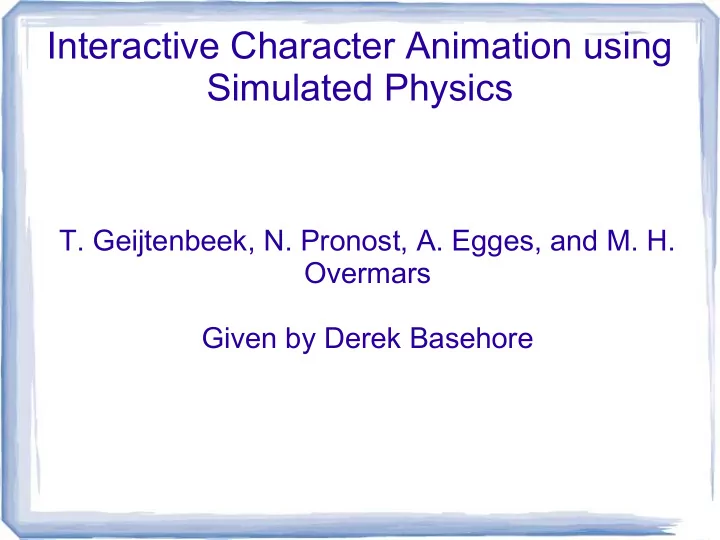

Interactive Character Animation using Simulated Physics T. Geijtenbeek, N. Pronost, A. Egges, and M. H. Overmars Given by Derek Basehore
Why use Physics? ● Responses to Actions in the simulated environment do not rely on existing data (kinematics) ● Can create unique reactions depending on the stimulus
How? 12 10 8 Column 1 6 Column 2 Column 3 4 2 0 Row 1 Row 2 Row 3 Row 4
Overview ● Forward Dynamics vs. Inverse Dynamics ● Actuation Modeling ● Motion Controllers ● Optimization
Forward Dynamics ● Compute the accelerations of simulated objects ● Based directly off of simple physics equations L = mv H = Iw − 1 ( c ( q ,q' )+ T ( q )τ+ e ( q )) q' ' = M ( q )
Inverse Dynamics ● Opposite of forward dynamics ● Instead of taking accelerations, you take a motion and find the acceleration needed to perform that motion. ● Motion data is analyzed to determine which motions to use − 1 ( M ( q ) q' ' + c ( q ,q' )+ e ( q )) τ= T ( q )
Different Actuation Models ● Muscle-Based Actuation ● Servo-Based Actuation ● Virtual Forces
Muscle-Based Actuation ● Computationally expensive, so real time simulations typically do not use it ● Need at least 2 muscles for every degree of freedom since muscles can only pull (hence more computationally intensive)
Servo-Based Actuation ● Every joint is controlled by a servo motor ● Can lead to more unnatural looking animation when optimization is used (as opposed to muscle-based actuation)
Motion Controllers ● Use sensor data to control the motion of the character ● Joint State, Contact Information, Center of Mass, Target Position, etc.
Joint-Space Motion Control
Stimulus-Response Network Control ● Creates strict relations between sensors and actuators ● Relies heavily on optimization – often uses evolutionary algorithms for offline optimization and reinforcement learning for online optimization
Videos of Research Projects ● http://www.youtube.com/watch?v=JBgG_VSP7f8 ● http://people.csail.mit.edu/jovan/assets/movies/abe-2007-mcf.mp4
Recommend
More recommend